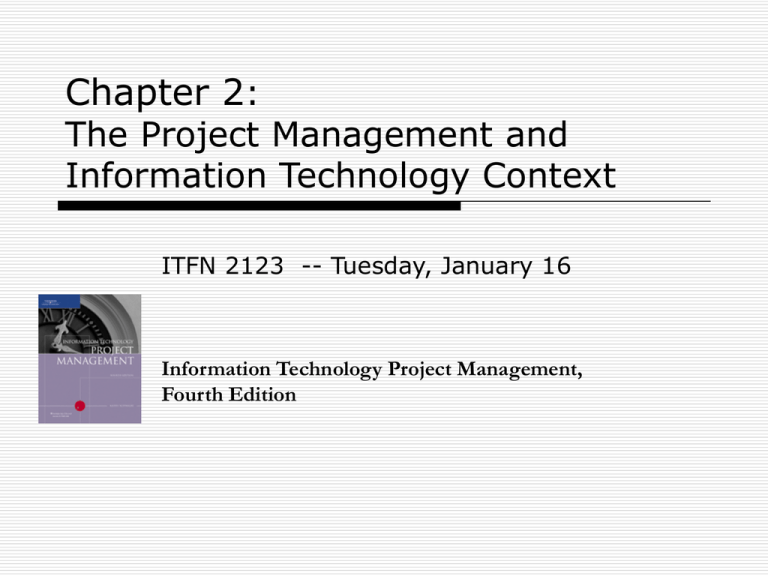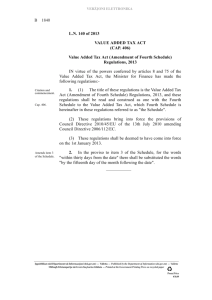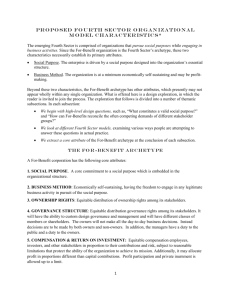Tuesday, Jan 16 - Chapter 2 - IT Context - Kahuna
advertisement

Chapter 2: The Project Management and Information Technology Context ITFN 2123 -- Tuesday, January 16 Information Technology Project Management, Fourth Edition Today’s Schedule Quick Check Self-Quiz Review Jobs/Project experiences Chapter 2 – IT Context Systems view of project management Understand organizations - organizational structures and organizational culture. Stakeholder management For Thursday, January 18 Check your access to WebSubmit Complete Reading Chapter 2 Information Technology Project Management, Fourth Edition 2 Quick Check What are 2 of the top 5 project success factors? List 3 specific job functions of the project manager. In Ch 2 “Opening Case”, list at least 3 stakeholders and one potential project sponsor. List 2 of the 4 frames we use to understand organizations. Information Technology Project Management, Fourth Edition 3 Project Success Factors* 1. Executive support 2. User involvement 3. Experienced project manager 4. Clear business objectives 5. Minimized scope 6. Standard software infrastructure 7. Firm basic requirements 8. Formal methodology 9. Reliable estimates 10. Other criteria, such as small milestones, proper planning, competent staff, and ownership *The Standish Group, “Extreme CHAOS” (2001). Information Technology Project Management, Fourth Edition 4 Table 1-3. Fifteen Project Management Job Functions* Define scope of project. Evaluate project requirements. Identify stakeholders, Identify and evaluate risks. decision-makers, and Prepare contingency plan. escalation procedures. Identify interdependencies. Develop detailed task list Identify and track critical (work breakdown milestones. structures). Participate in project phase review. Estimate time Secure needed resources. requirements. Manage the change control Develop initial project process. management flow chart. Identify required resources Report project status. and budget. *Northwest Center for Emerging Technologies, “Building a Foundation for Tomorrow: Skills Standards for Information Technology,” Belleview, WA, 1999. Information Technology Project Management, Fourth Edition 5 Understanding Organizations Structural frame: Focuses on roles and responsibilities, coordination, and control. Organization charts help define this frame. Human resources frame: Focuses on providing harmony between needs of the organization and needs of people. Political frame: Assumes organizations are coalitions composed of varied individuals and interest groups. Conflict and power are key issues. Symbolic frame: Focuses on symbols and meanings related to events. Culture is important. Information Technology Project Management, Fourth Edition 6 Today’s Schedule Quick Check Self-Quiz Review Jobs/Project experiences Chapter 2 – IT Context Systems view of project management Understand organizations - organizational structures and organizational culture. Stakeholder management Information Technology Project Management, Fourth Edition 7 Learning Objectives Describe the systems view of project management and how it applies to information technology projects. Understand organizations, including the four frames, organizational structures, and organizational culture. Explain why stakeholder management and top management commitment are critical for a project’s success. Information Technology Project Management, Fourth Edition 8 Projects Cannot Be Run in Isolation Projects must operate in a broad organizational environment. Project managers need to use systems thinking: Taking a holistic view of a project and understanding how it relates to the larger organization. Senior managers must make sure projects continue to support current business needs. Information Technology Project Management, Fourth Edition 9 A Systems Approach to Project Management Holistic and analytical approach to solving complex problems, including: Systems philosophy: View things as systems, which are interacting components that work within an environment to fulfill some purpose. Systems analysis: Problem-solving approach. Systems management: Address business, technological, and organizational issues before making changes to systems. Information Technology Project Management, Fourth Edition 10 Figure 2-1. Three Sphere Model for Systems Management Information Technology Project Management, Fourth Edition 11 Understanding Organizations Structural frame: Focuses on roles and responsibilities, coordination, and control. Organization charts help define this frame. Human resources frame: Focuses on providing harmony between needs of the organization and needs of people. Political frame: Assumes organizations are coalitions composed of varied individuals and interest groups. Conflict and power are key issues. Symbolic frame: Focuses on symbols and meanings related to events. Culture is important. Information Technology Project Management, Fourth Edition 12 What Went Wrong? Many enterprise resource planning (ERP) projects fail due to organizational issues, not technical issues. For example, Sobey’s Canadian grocery store chain abandoned its two-year, $90 million ERP system due to organizational problems. The system was developed by SAP, the largest enterprise software company and 3rd largest s/w supplier. As Dalhousie University Associate Professor Sunny Marche states, “The problem of building an integrated system that can accommodate different people is a very serious challenge. You can’t divorce technology from the sociocultural issues. They have an equal role.” Sobey’s ERP system shut down for five days and employees were scrambling to stock potentially empty shelves in several stores for weeks. The system failure cost Sobey’s more than $90 million and caused shareholders to take an 82-cent after-tax hit per share.* *Hoare, Eva. “Software Hardships,” The Herald, Halifax, Nova Scotia (2001). Information Technology Project Management, Fourth Edition 13 Many Organizations Focus on the Structural Frame Most people understand what organizational charts are. Many new managers try to change organizational structure when other changes are needed. Three basic organizational structures: Functional: Functional managers report to the CEO. Project: Program managers report to the CEO. Matrix: Middle ground between functional and project structures; personnel often report to two or more bosses; structure can be a weak, balanced, or strong matrix. Information Technology Project Management, Fourth Edition 14 Figure 2-2. Functional, Project, and Matrix Organizational Structures Information Technology Project Management, Fourth Edition 15 Table 2-1. Organizational Structure Influences on Projects Project Characteristics Organizational Structure Type Functional Weak Matrix Project manager’s authority Percent of performing organization’s personnel assigned full-time to project work Who controls the project budget Matrix Balanced Matrix Low to Moderate 15-60% Project Strong Matrix Moderate to high 50-95% High to almost total 85-100% Little or none Limited Virtually none 0-25% Functional manager Functional manager Mixed Project manager Project manager Project manager’s role Part-time Part-time Full-time Full-time Full-time Common title for project manager’s role Project Coordinator/ Project Leader Project Coordinator/ Project Leader Part-time Project Manager/ Project Officer Part-time Project Manager/ Program Manager Full-time Project Manager/ Program Manager Full-time Project Part-time management administrative staff PMBOK Guide, 2000, 19, and PMBOK Guide 2004, 28.Project Information Technology Management, Fourth Edition 16 Ten Characteristics of Organizational Culture Member identity* Group emphasis* People focus Unit integration* Control Risk tolerance* Reward criteria* Conflict tolerance* Means-ends orientation Open-systems focus* *Project work is most successful in an organizational culture where these characteristics are highly prevalent and where the other characteristics are balanced. Information Technology Project Management, Fourth Edition 17 Organizational Culture Organizational culture is a set of shared assumptions, values, and behaviors that characterize the functioning of an organization. Many experts believe the underlying causes of many companies’ problems are not the structure or staff, but the culture. Information Technology Project Management, Fourth Edition 18 Stakeholder Management Project managers must take time to identify, understand, and manage relationships with all project stakeholders. Using the four frames of organizations can help you meet stakeholder needs and expectations. Senior executives and top management are very important stakeholders. Information Technology Project Management, Fourth Edition 19 Importance of Top Management Commitment Several studies cite top management commitment as one of the key factors associated with project success. Top management can help project managers: Secure adequate resources. Get approval for unique project needs in a timely manner. Receive cooperation from people throughout the organization. Learn how to be better leaders. Information Technology Project Management, Fourth Edition 20 Need for Organizational Commitment to Information Technology (IT) If the organization has a negative attitude toward IT, it will be difficult for an IT project to succeed. Having a Chief Information Officer (CIO) at a high level in the organization helps IT projects. Assigning non-IT people to IT projects also encourages more commitment. Information Technology Project Management, Fourth Edition 21 Need for Organizational Standards Standards and guidelines help project managers be more effective. Senior management can encourage: The use of standard forms and software for project management. The development and use of guidelines for writing project plans or providing status information. The creation of a project management office or center of excellence. Information Technology Project Management, Fourth Edition 22 With a New Partner Select a recent change (or proposed change) at Clayton or Atlanta? 1. 2. 3. 4. 5. As of Jan 1, 2007, Joshua's Law - Driver's Ed req'd to get license at 16! But Driver Ed not available in H.S. Clayton State University changing class schedules from M-W to M-W-F Building a new student activity center Register and pay for Spring by Dec 8 HUB support hours and appointment process Information Technology Project Management, Fourth Edition 23 Analyzing this change … 1. 2. 3. List at least 5 stakeholders in this change and at least one potential “project sponsor” of this change. List at least 2 issues surrounding this change or proposal for each of the 3 spheres: business, organization and technology. Describe 2 strategies to manage stakeholders. Information Technology Project Management, Fourth Edition 24 For Thursday, January 18 Complete Reading Chapter 2 Information Technology Project Management, Fourth Edition 25





